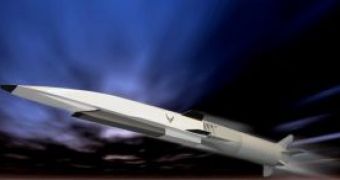"As fast as the sound"...
That's slow, as hypersonic missiles will strike targets around the globe.
For long, scientists have been trying to build hypersonic aircraft that could whip around the world in just a few hours. Till then, missiles are more at reach. Missiles are easier to develop because "you don't need them to come back and because they are about 10 times smaller than hypersonic aircraft would have to be," says Kevin Bowcutt, a senior hypersonics specialist at the US aerospace firm Boeing Phantom Works.
First hypersonic aircraft was made by NASA - the 2004 X-43A test vehicle - which reached 9.6 times the speed of sound (Mach 9.6) but stopped the research after that. Now, the US and Australia Armies are leading the research. The projects have developed a test vehicle called the X-51A (photo), run jointly by the US Air Force and the US Defense Advanced Research Projects Agency (DARPA), and a separate DARPA vehicle called Falcon. 10 test flights will be carried on the next five years in a common US-Australian program called HIFiRE (Hypersonic International Flight Research Experimentation).
All of these are based on scramjets (supersonic combustion ramjets), which - unlike the rockets - mix fuel with air and ignite the mixture as it flows through the engine at supersonic speeds. The rockets need to carry oxygen to ignite their fuel. Scramjets suck in and compress air at supersonic speeds, unlike jet plane engines, which use fans to compress air. The engine for the X-51A uses the gas flow system tested in NASA's vehicle, with a rectangular intake, which compresses the air and generates a shock wave that pushes the air through the engine vertically. It will be mounted on a solid rocket booster and fired from a B-52 bomber flying at an altitude of about 10 km. The first flight tests are scheduled for mid- to late 2007 and the vehicle will kick in after the rocket reaches Mach 4.5, boosting its speed to nearly Mach 7.
Instead, the HIFiRe project employs a 3-D gas flow system, whose purpose is to compress the gas in three dimensions - sideways as well as vertically - using a round intake. The extra dimension of compression allows "more shock waves and more efficient compression of the flow with lower losses", says Bill Lyons, manager of international research analysis at Boeing Phantom Works. The design should drop atmospheric drag, allowing the vehicle to increase its range or the weight of its load. Ten tests of HIFiRE are scheduled in 2007 on the Woomera range in South Australia.
The goal of the project is to create advanced scramjets able of sustained flight faster than Mach 8. DARPA's Falcon project is even more ambitious, with plans to reach Mach 15 to 20 - speeds needed to reach and return from orbit and its first test flights are planned for December 2008. Even with all these projects, hypersonic flight is still a long way off. US Air Force will operate the first missiles in 2035, and unmanned aerial vehicles that could fly as far as 3000 km (1800 miles) are even further off. "We're pretty close to the point where we could design a missile, but we're not there," Lyons says.
But, in the longer term, air-using hypersonic craft could cut the cost of reaching space.

 14 DAY TRIAL //
14 DAY TRIAL //